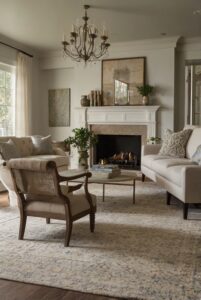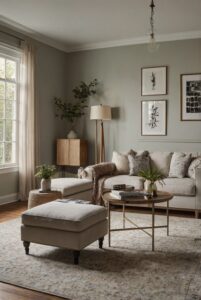Are you struggling with arranging furniture in a living room with an open floor plan? Dive into the daily routine of an interior designer and discover stylish decor tips!
How do you arrange furniture in a living room with an open floor plan?
Living rooms with open floor plans offer a unique challenge when it comes to furniture arrangement. To make the most of the space, consider grouping furniture into conversational areas to define different zones within the room. Use area rugs to anchor each seating arrangement and create a cohesive look. Keep traffic flow in mind to ensure the room feels open and inviting. Wall-mounted shelves can be a great way to add storage and display space without cluttering the floor. Experiment with different layouts to find what works best for your needs and the flow of the room.
How to Arrange Furniture in a Living Room with an Open Floor Plan
In a living room with an open floor plan, it is essential to create distinct zones for different functions while maintaining a sense of cohesion and flow. Here are some important tips to help you arrange furniture effectively:
Consider the Functionality
Before you start arranging furniture, consider how you will use the space. Determine the main activities that will take place in the living room, such as watching TV, entertaining guests, or reading. This will help you identify the key pieces of furniture you need and where to place them.
Create Zones
Divide the living room into different zones based on the activities you identified. For example, you can have a seating area for watching TV, a dining area for meals, and a reading nook for relaxation. Use area rugs, lighting, and furniture placement to define each zone.
Focus on Flow
Ensure there is a clear pathway between the different zones to allow for easy movement. Avoid blocking the flow of traffic with furniture arrangements. Consider the natural traffic patterns in the room and arrange furniture accordingly.
Use Versatile Furniture
When arranging furniture in an open floor plan living room, choose versatile pieces that can serve multiple functions. For example, opt for a sofa with a chaise lounge that can be used for both lounging and watching TV. This will help maximize space and flexibility in the room.
Consider Scale and Proportion
Pay attention to the scale and proportion of furniture in relation to the size of the room. Avoid overcrowding the space with oversized furniture or filling it with too many small pieces. Create a balance by mixing large and small-scale furniture to create visual interest.
In conclusion, arranging furniture in a living room with an open floor plan requires careful consideration of functionality, zoning, flow, furniture versatility, and scale. By following these tips, you can create a well-designed and functional living space that meets your needs and enhances the overall look and feel of your home.
1. What are the key considerations when arranging furniture in a living room with an open floor plan?
When arranging furniture in a living room with an open floor plan, it is important to consider the flow of the space. Start by defining different zones within the room for specific functions such as seating, dining, or entertainment. Use area rugs to delineate these zones and create visual boundaries. Additionally, consider the scale and proportion of the furniture to ensure that it fits the space without overwhelming it. Finally, make sure to leave enough space for easy circulation and movement between the furniture pieces.
2. How can you create a cohesive look when arranging furniture in an open floor plan living room?
To create a cohesive look in an open floor plan living room, choose a consistent color palette and style for the furniture pieces. This will help tie the different zones together and create a harmonious flow throughout the space. Additionally, consider using furniture pieces with similar design elements or materials to create a sense of unity. You can also add decorative elements such as throw pillows, curtains, or artwork that complement the overall aesthetic of the room.
3. What are some furniture arrangement tips for maximizing space in an open floor plan living room?
One effective way to maximize space in an open floor plan living room is to use multifunctional furniture pieces such as ottomans with storage or nesting tables. These pieces can serve multiple purposes while taking up minimal space. Additionally, consider using furniture with clean lines and open bases to create a sense of openness and airiness in the room. You can also experiment with different furniture layouts to find the arrangement that best suits your needs and maximizes the available space.
4. How can you balance the different zones in an open floor plan living room when arranging furniture?
Balancing the different zones in an open floor plan living room is essential to create a cohesive and functional space. Start by arranging the furniture in a way that maintains a clear sightline between the different zones. This will help create a sense of connection and flow throughout the room. Additionally, consider using furniture pieces of varying heights and sizes to add visual interest and balance to the space. You can also use area rugs or lighting fixtures to anchor each zone and create a sense of definition within the open floor plan.
5. What are some common mistakes to avoid when arranging furniture in a living room with an open floor plan?
One common mistake to avoid when arranging furniture in a living room with an open floor plan is overcrowding the space. Make sure to leave enough room for circulation and movement between the furniture pieces to maintain a comfortable and functional layout. Another mistake is neglecting the scale and proportion of the furniture, which can lead to a cramped or unbalanced look. Additionally, avoid placing all the furniture against the walls, as this can create a disconnected and disjointed feel in the room. Instead, try to create cozy conversation areas by floating furniture in the center of the space.




